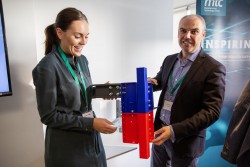In the 1970s, the US car industry was severely impacted by Japanese car manufacturers who had perfected a highly efficient production system. The US car manufacturers came together and collaborated to develop a standardised approach to aggregate demand and reduce cost.
We in the Seismic consortium identified a tremendous opportunity to adopt a similar collaborative approach to improve the efficiency of school construction.
Ambitious aims
The overriding aim of the Seismic project was to increase efficiency to reduce cost by standardising the offsite frame dimensions across the industry to create a componentised system for building new schools, beginning with primary facilities.
The aim was also to simplify the design process at the earliest stage – ensuring both feasibility and compliance with Department for Education (DfE) requirements in the most efficient way possible. Our solution would be to develop a digital version of the standardised DfE school clusters that would allow teaching professionals to assess if a compliant school building can fit on a specific site. This tool would use standard module sizes as a kit of parts for designing a school.
The project partners
• Bryden Wood provided digital expertise and led the development of the technology for the configurator.
Standardisation and volume are always key for efficient manufacturing. If processes are more efficient and there are fewer components, labour costs are reduced. This means the focus can be on the quality of the materials and achieving best value.
The standardised grid and connecting solution simplify the design process and enable the second part of the project – the configurator tool – that allows a non-construction professional to configure a fully DfE-compliant school on a specific site. The intention is to speed up the early feasibility process.
Offsite framing solution for schools
The principle of standardised, manufactured components is that greater volumes will drive down costs and simplify procurement. For example, the DfE can pre-order a series of modules from any manufacturer that will be available 'off the shelf' for faster-building assembly when a site receives planning.
The benefits: Productivity, cost and environmental
By rationalising the design of the steel frame, the number of components has been reduced. This means faster module assembly in the factory – increasing productivity by up to 50%. Work on-site to interconnect modules is also more efficient.
The partners' research has shown that the new solution significantly reduces the number of frame components and will, therefore, use 25% less steel. The reductions in steel components and assembly time combine to generate a cost-saving for these elements of up to 25%.
With fewer components, the weight of the modules will reduce by 25% with no compromise on structural rigidity – generating 25% lower carbon emissions for the offsite construction of an average 40-module school. This is equivalent to over 155,000 miles of car driving or 17 flights from London to Sydney.
A unique approach to achieve unprecedented economies of scale
This collaborative, standardised approach will make it easier for clients to procure offsite, for the supply chain to manufacture components and for offsite specialists increase to productivity.
The Seismic School Configurator
The team at Bryden Wood has developed a web app that encodes the spatial requirements alongside guidance for DfMA. Game engine technology was used to build the configurator and to make it as much like a computer game as possible. Games such as Minecraft provided inspiration for the look and feel – the team wanted it to be different to the costly, professional desktop software that architects normally use.
A web app rather than a desktop application was created so the configurator could be as open and widely available for users as possible. This is a tool which is useful for architects who are designing schools in a conventional way and it will also allow a larger group of stakeholders to get involved. Teachers, parents and pupils can potentially design their own school.
An open-source approach
The team wants to encourage as many people as possible to get involved. Open-sourcing technology is often disruptive – this approach lowers the barrier to entry and helps to democratise the design process.
The app can be accessed here.
Seismic: A powerful example to inspire other innovative projects
"The focus of Seismic was to realise the government's ambition for greater productivity in construction and this has definitely been achieved with the offsite and digital solutions developed by the team. We are in no doubt that these innovations have the potential to change the way primary school projects are designed, procured and constructed, helping to meet the rising demand for school places and increase capacity in the construction industry."
Next steps
The benefits are already being realised in new Department for Education procurement frameworks. The team is in the process of completing testing of the frame solution. The next stage is a collaboration with steel fabricators to develop the standardised components and establish a supply chain with a view to making these available to the offsite market in the coming months. This approach will aggregate demand to reduce cost.









